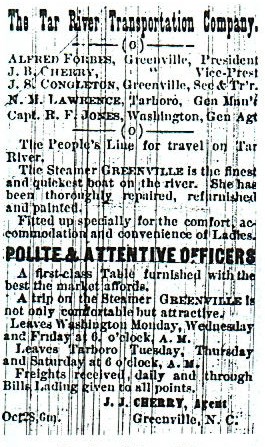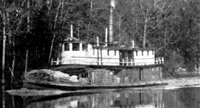Riverboats of the Tar River
Forgotten places and boats
Roads were generally poor in Edgecombe County until well after the Civil War. The railroad didn't come to Tarboro until 1882. In part this was because the Tar River was navigable as far up river as Tarboro. Steamboats did a thriving business transporting cargo and people. The January 27, 1962 edition of the Daily Reflector carried the article that follows about a trip down the Tar River in 1888.
Trip Down the Tar River
"About the turn of the century when the railroads began to come into the
county, the day of the steamboat of the Tar started to fade. "And along with
their going out the small landing places that owed their existence to the
steamboat began to lose their significance and in some cases their identity.
And along with the march of the progress, the names of the steamboats - names
 almost as
familiar as
those of the
peoples that lived on the river, became
something to be remembered. "In 1888 young Bruce Coften, of Coffendale made a
trip down the Tar on the steamer, Greenville. In his book, written when he
was grown, he tells of some of the sights and landing places he saw on his way
down river."
almost as
familiar as
those of the
peoples that lived on the river, became
something to be remembered. "In 1888 young Bruce Coften, of Coffendale made a
trip down the Tar on the steamer, Greenville. In his book, written when he
was grown, he tells of some of the sights and landing places he saw on his way
down river."
The Greenville
"The steamer Greenville was the finest on the river. Her skipper was Captain Mayo, and he was assisted by "polite and attentive officers." The Greenville also set a "first class table furnished with best the markets offer. It also boasted of the "finest and quickest service on the river," with adequate accommodations for the ladies."
Monday,Wednesday,Friday
"The Greenville pulled out from Tarboro on the even days of the week at 6 a.m. Eight miles below Tarboro, the steamer pulled Into Old Sparta. The tiny village, the "first place settled on the Tar". As the Geenville started on down the river, she passed Carrs Landing and went on toward Penny Hill which was two miles farther downstream.
Penny Hill
"Here at Penny Hill, named for a "free woman of color," who used to sell "tabacco and eatables" for the flatboat men of earlier days, the Tar widens. Penny Hill had a good landing place and was a very "attractive spot. " After unloading some freight and taking on a passenger or two, the Greenville steamed on. Next was Dupree's Landing and as there was nothing on board for this place, the boat went the three miles to the landing for Falkland and pulled in toward the shore.
Tobacco Patch or Pillsboro
"This place was once known as Tobacco Patch and earlier than that Williams Landing. Some time before the civil war, a store was opened here. On the whole, the place was an unhealthy one. it was due to this fact that some pre-civil war wit stuck the name Pillsboro on it. "It has stuck until this day. The modem bridge that crosses the Tar at this spot is called Pillsboro Bridge.
Bensborough
"Just below Pillsboro, stood Bensborough, the old home place of the Atkinson family. For many years Bensborough had a post office, a store and a ferry. Old Bensborough place of the legend of the Mirrors, with it, magnolia trees and Boxwood gardens, One mile down river, the Greenville came to Center Bluff where the Coftens had- a store and a landing.
On To Greenville
"After pulling out from Center Bluff ' the Greenville passed
Reeves Landing, Bluebanks, Randies Barn, and Slaughter House point. At
Greenville, much freight was unloaded, and many passengers went ashore.
And
then freight and passengers came aboard.

The Last Fifteen Miles
"After passing Great Bend, the river widens and it is easy sailing to the end of the trip. The banks of the river are lined with great trees an rank underbrush. The captain relaxes, the worst is over. Most of the sandbars and snags have been passed. Ahead can be seen the spires of the churches and buildings of Washington. As the steamer nears the town at the six forks of the Tar, people start get ready to set their feet on dry land. The deck hands look to their ropes and the freight handlers make ready to unload. "Tomorrow and every uneven day of the week, but Sunday, the Greenville -would go back up to Tarboro, passing the same small landing places - loading and unloading.
This Was Yesterday "This was yesterday, a long time ago. The names of the boats that plied the river are but forgotten. Tucked away in some faded print or in the minds of one or two oldsters who remember. "Long gone are the boats, the Amidas (1849),the first permanent one assigned to Tar. The Post Boy, the Govemor Morehead both destroyed when the Yankees took Tarboro in 1863. "The stem wheeler, Cotton Plant, freighter and one-time tender of the Ram Albemarle, ending her day, by being burned above Old Sparta. "The Myers, under the card playing Capt. Porvin. The Tarboro, the Shiloh, and others that dodged the sand bars and snags of the river, all gone. "But they say of all those, the Greenville was the most famous of the steamers that swam the Tar.
